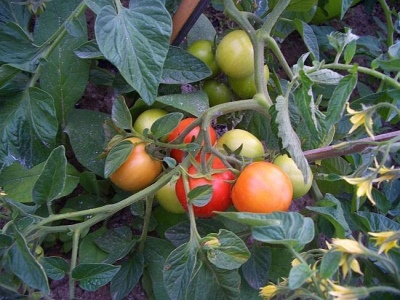
- Name synonyms: Shcelkovskii Rannii
- Category: grade
- Appointment: universal
- Ripening period: ultra early
- Ripening time, days: 80-100
- Growing conditions: for film greenhouses
- Bush size: dwarf
- Bush height, cm: 30-35
- Bush characteristic: compact
- Leaves: potato type
Despite the variety of tomato species offered by agricultural firms, many gardeners prefer proven, classic varieties that can give stable yields even in extreme conditions. These include the early Shchelkovsky tomato.
Breeding history
Schelkovsky early is a tomato with a long history, bred by Soviet breeders more than 30 years ago. Recommended for cultivation in all climatic zones of the country. The nightshade crop is equally productive in the beds, and in film greenhouses, and in mini-greenhouses.
Description of the variety
The Schelkovsky early tomato is a low-growing plant of the determinant type, growing in height by 30-35 cm. Sometimes this tomato type is called dwarf because of the short stature and compactness of the bushes. The bush is characterized by thin stems, weak foliage thickening of a light green color, a medium-developed root and simple inflorescences. After the appearance of 6 fruit cluster, the stem stops growing on its own. On a healthy tomato bush, 7-9 fruit clusters are formed, where 5-6 berries are tied.
During cultivation, the bushes do not need to be tied to the supports, since they are very low, and they do not need to be pinned and thinned out. You can form bushes at will - in 1 or 2 stems. The purpose of tomatoes is universal, so they are ideal for fresh salads, for processing into dressings and drinks, for pickling and pickling, and, of course, for canning whole fruits.
The main qualities of the fruit
Tomato Schelkovsky early represents the category of medium-fruited Solanaceae. The weight of the vegetable reaches 40-60 grams. The shape of tomatoes is regular, rounded, without ribbing on the surface. Ripe tomato has a uniform deep red color, and at the stage of technical maturity - light green. The peel of vegetables is thin, glossy, not hard. The tomato is endowed with moderate resistance to cracking, good transportability and poor keeping quality, like most early maturing species.
Taste characteristics
Schelkovsky early vegetable attracts not only with its ideal shape, but also with excellent taste. The pulp of the fruit is fleshy, tender, juicy, with few seeds. The taste of tomatoes is classic - sweet and sour with a pronounced spicy aroma. When grown in a rainy summer, tomatoes can completely lose their sweetness and become more sour.
Ripening and fruiting
Tomatoes belong to the ultra-early class. Only 80-100 days pass from mass germination to ripe fruits on the bushes. Fruits ripen quickly. The first tomatoes from the garden can be removed in the second half of June, and the peak of fruiting occurs in July.
Yield
Productivity is one of the advantages of this vegetable crop. Providing standard agricultural techniques, a decent harvest can be harvested per 1 m2 - from 8 to 9 kg of ripe tomatoes.
The timing of planting seedlings and planting in the ground
The culture is grown in two ways - through sowing seeds in the ground and seedlings, which is more convenient and simple. Sowing seeds is carried out in March. The seed is pre-sorted and disinfected. Germination occurs on the 7th day.Seating in individual pots is carried out at the stage of growth on a bush of 2-3 leaves. 10-14 days before transplanting, plants begin to harden so that they quickly adapt to new conditions.
Transplantation to a new place is carried out at the stage of the appearance of 4 true leaves at the age of 55-60 days. Depending on the climate and growing conditions, transplanting is carried out from the end of May to the beginning of June.

Growing tomato seedlings is an extremely important process, because it largely depends on whether the gardener can harvest at all. All aspects must be taken into account, from seedbed preparation to planting in the ground.
Landing scheme
In order for plants to receive sufficient oxygen and light, they must be correctly positioned on the site. 6-8 bushes can be planted per 1 m2. Recommended for planting is a 50x30 cm scheme.

Growing and caring
The classic tomato look is absolutely not capricious in care and undemanding to the soil, the main thing is that the soil is breathable, loose and fertile. The most favorable environment is considered to be the one where zucchini, cabbage and radish used to grow.
Comprehensive crop care consists of basic measures: moderate irrigation with warm water, top dressing, loosening and weeding of the soil, prevention of diseases and pest infestations. In the greenhouse, you need to control the humidity level.




A plant needs different micronutrients at each stage of growth. All fertilizers can be divided into two groups: mineral and organic. Folk remedies are often used: iodine, yeast, bird droppings, eggshells.
It is important to observe the rate and period of feeding. This also applies to folk remedies and organic fertilizers.
Disease and pest resistance
The tomato is endowed with high immunity, therefore, diseases common among nightshade crops are rarely affected. It is possible to provide protection against insect infestation if preventive treatments with insecticides are carried out.


Resistant to adverse weather conditions
This variety has a high resistance to stress. It easily tolerates temperature drops, short drought and heat. In addition, the plant is not afraid of shading and thickening.

























































































